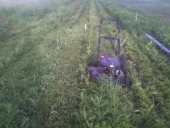Never used any of the newer costly mauls or axes most have talked about so a little old school here.
Sure are some sweet looking new toys. Like the video on the hammer mill, thanks for sharing.
Here (western PA ) with our hard woods we use a 8 lbs head with Fiberglass handle. Fiberglass for durability.
Love the feel of wood but helpers are all too hard on the wooden handles. Anything over 16 " or so in diameter
is just a little much for a 6 lbs maul head.
Have 4; 8 lbs maul heads and one is better then the rest. It is a cheap Japan made head,
looks the same as other all the other maul heads, almost same length and shape.
Have 3; 6 lbs heads for smaller sizes.
Take a 8 lbs sledge and few wedges with us. Maybe a sharp double headed axe and hatchet. Just in case.
If splitting wood by hand is an art, splitting locust posts is the craftsman end of it. You have to learn the wood is made different.
Grains and knocks are killers and can stop you cold in your tracks or destroy your post. A wind checked log needs a hydraulic
splitter, just not worth the trouble. Seen a 18" 20' cherry log take two of us 1.25 hours to split, for two rows across a truck bed. It was free and easy
to get to but we had to pass on that stand, just too hard to split. One other time, two of us took 2 hours for a Red Oak log 24" 14' to split, by far the hardest log
I've ever split, never again.
Which way does a tree grow? Trees are made to take weight down. So 80 percent of the time hit the root end. If you image an arrow pointing in the
direction of the sky, think about it that way. Your tool will want to bounce off the the pointy arrow. Hit the back of the arrow and it will split easier. That said it
not the case at stump bulge, these are best for making splitting base. Branches is a rough area to split, some just will not, and need to be cut or use hydraulics.
If you look at a log. Look for knots and straighter grains, start with the straight grain ends the pieces split easier. Looking mostly knots, burris (sp) or other items,
like cables, wire and bolts, even cement all are items to looks for. Here we get wood from town time to time but allot from field edges and fence rows, never
know what you'll find.
Splitting base which should only be around 8-10 " high not 16-24" most are too high and you losing the strongest part of your swing, end of you swing. Place
base on hard ground, use the driveway, road, I've even use a hard wood hay wagon many times. As you set a log up look for natural checking (splitting) follow the
natural way the wood is going, starting there. On larger pieces diameter 24-32" maybe start on an edge, knock off about 3-6 " and go around working to center,
then you end up with some nice pieces for making kindling. Or we fire up a chainsaw and cut in half, do not long for a 85 cc saw.
Post splitting is a art an I'm better at showing then typing it all out. Here's where wedges, craftsmen grade axes, hatchets and a good light chain saw come
into play. The largest I ever split was a 22-28 " diameter log sum 22' long to make a grape arbor. Finished the grape arbor was 20' by 18' and allot of work. Should
last some 25-30 years all split Black Locust grade 1 and 2 not any soft of green wood use all debarked, set in dry ground, and hand set, not cement in.
Wood I will not split, American Elm, or trees that are wind checked. Couple of others I know not the name of them, thought one was a nut like butter nut but I'm not sure.
We don't burn any pine or spruce here. Oak (red and white), Cherry, Maple (hard and soft), Hickory, Locust, Nuts trees, Sassafras, Birch, Beech and fruit trees. Few other
types to.






